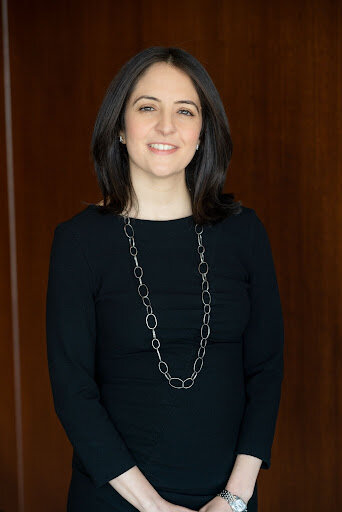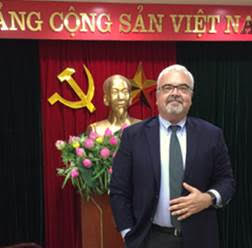Best of Both Worlds: Goldman Sachs’ Stephanie Cohen
Matthew Van Buskirk
My guest today is one of the most high-ranking women in the world of banking. Stephanie Cohen is Global Co-Head of Consumer and Wealth Management, Goldman Sachs. In that role, she co-leads Goldman’s digital bank, Marcus.
We have talked on the show before -- and we do so again today -- about the uniqueness of Marcus. It’s a rare hybrid: a wholly new financial company, created by an old one -- in this case, by one that is 152 years old. That combination opens the possibility of being the best of both. Unlike most old financial companies, Marcus has a brand new, from-scatch, digital first -- I call it digitally native -- technology stack. Unlike most young companies, it can offer a full set of services, and also knows how to be a regulated financial entity. Having both halves of this equation is a massive advantage over having just one half, which is what nearly all its competitors have -- either one or the other, but not both. Both the incumbents and the startups in the financial world are struggling to get the half that’s missing. As we talk about on this show all the time, that’s not easy.
In our conversation, Stephanie explains the Marcus strategy. They are moving rapidly to offer a full spectrum of services in hopes of being people’s primary bank, one that is digital first, informed by data, and designed to make life easy.
She also talks about Goldman’s second consumer strategy, which is to embed the same capabilities, plus credit card, in the offerings of partner organizations -- think of the Apple Card. Stephanie says people today expect the bank to come to them, to join them in the digital ecosystems they already use or, as she puts it, that they already know and love.
Central to both of these Goldman businesses is digitization. Stephanie takes us beyond the buzzwords to describe what digitizing financial services can mean to the customer. She points to the ability to extend wealth management services to people whose wealth wouldn’t qualify them for traditional programs. She describes Goldman’s use of behavioral science to help people make choices that will build financial health. She talks about reimagining product design, and shifting card users from revolvers to transactors, and helping people pay several times a month, and ways to overcome declined credit, and ways for whole families to build credit histories together. She says that the ONLY way to expand credit access is to learn to underwrite the PERSON, instead of the credit score, and she says doing this requires having more data.
Stephanie believes these kinds of upside opportunities from digitization will outweigh the downside risks -- as do I, assuming the industry and regulators attend to related risks on privacy and potential bias. Our conversation did cover these unintended consequences that can arise, especially as new concepts are first introduced. Stephanie emphasizes that they are just at the start of building this new kind of bank and that innovation is hard. She talks about the keys to doing it right, including the need for experimentation and for getting all the right people in the room. That sounds simple, but as she says, it’s difficult.
Related to that, Stephanie says diverse teams clearly outperform monolithic ones, but that businesses just don’t build them, and VCs don’t fund them. She cites the “strange circumstance” that 90% of venture capital dollars go to all-male teams and 99% to all-white teams, neither of which reflects the world around them. She talks about what Goldman is doing about it -- and note her invitation to like-minded investors and institutions who want to partner.
I asked Stephanie for advice for women who aspire to follow a career arc like hers. She has some really interesting insights for them, and also for male leaders trying to get this right.
Stephanie was once a competitive figure skater with Olympic ambitions. With the Tokyo games fresh in mind, it’s thought-provoking to hear her talk about the lessons you learn from sports like skating. You will fall down. Then you will get back up and try again. It’s a wonderful metaphor for innovation.
Links
More on Stephanie
Stephanie Cohen is Global Co-Head of Consumer and Wealth Management and a member of the Management Committee. She is also a member of the Global Inclusion and Diversity Committee, serving as a Global Executive Sponsor of the Women’s Network.
Prior to assuming her current role, Ms. Cohen was the firm’s Chief Strategy Officer, where she drove strategy, Mergers & Acquisitions (M&A), strategic investing and partnerships for the firm. She also led Launch With GS, Goldman Sachs’ $500 million commitment to invest in companies and investment managers with diverse leadership, as well as GS Accelerate, the firm’s in-house innovation engine. Before that, Ms. Cohen was Global Head of Financial Sponsor M&A in the Investment Banking Division (IBD). Ms. Cohen was Sector Captain for General Industrials in the Global Industrials Group and a member of the M&A Group in IBD. In 2008, she managed Conflicts and Business Selection for IBD in the Americas. Prior to that, Ms. Cohen was a Vice President in the Industrials and Merger Leadership Groups in San Francisco. Earlier in her career, she worked in New York in the M&A department. Ms. Cohen joined Goldman Sachs as an Analyst in 1999, was named Managing Director in 2008 and Partner in 2014.
Ms. Cohen serves on the National Board of Directors of CollegeSpring and as a member of the Board of Quill.org. She also serves as trustee for the Board of The Economic Club of New York.
More for our Listeners
Please follow AIR on LinkedIn and Twitter, and also please follow me personally on Twitter @JoAnnBarefoot. And be sure to leave us a five-star rating on your favorite podcast platform.
AIR is hiring! We need a project manager for our TechSprints and a global head of marketing and communications. We promise an exciting, creative experience with our young, fast-growing nonprofit. The postings are at www.regulationinnovation.org/join-air.
Coming soon on Barefoot Innovation, we will be making my 2021 SXSW session with Cleve Mesidor, on Diversifying Tech, into a podcast. We are very excited about a podcast this fall with the Netherlands’ Queen Maxima, who is the Global Advocate for Financial Inclusion for the United Nations. We’re also going to do a fascinating show on AI and fairness with Lisa Rice of the National Fair Housing Alliance and Kareem Saleh, CEO of FairPlay.
By popular demand, I’m also recording our whitepaper, the Regtech Manifesto, as a podcast. The Manifesto has been out now for over a year but continues gaining traction and generating great feedback. Recording it takes time, but coming soon!
Make sure to listen to our recent podcast with Energy Web CEO Jesse Morris on Crypto and Climate and, for those interested in climate and green finance, please join David at the IPPNY Fall Conference — that’s the Independent Power Producers of New York. David will also speak at AITE Group’s Financial Crime Forum and at Aire Talks (no relation to our AIR).
Meanwhile I’ll speak September 21 at NFCC Connect for the National Foundation for Credit Counseling (I’m on their board). And don’t forget to register for my presentation at the FDIC’s great fall conference -- I’ll speak about ‘Banking on Data: Great Possibilities, Great Responsibilities!’ I’ll also be speaking at SCxSC 21, hosted by the securities regulatory commission in Malaysia.
And of course I’ll be at Money 2020 -- which is scheduled to be back in person again this year -- for a discussion with Hummingbird CEO Matt Van Buskirk and with Brian Brooks. Brian, of course, is the former acting Comptroller of the Currency and was, briefly this year, CEO of Binance US, and we’re going to talk about regulation and cryptocurrency. We’ve started brainstorming our talk and are planning to shake things up, so don’t miss it!
The views and opinions expressed during the Barefoot Innovation podcast series are solely those of the individuals involved and do not necessarily represent those of Barefoot Innovation Group and its employees. Barefoot Innovation Group does not verify for accuracy the information contained in the podcast series. The primary purpose of this podcast series is to educate and inform.











